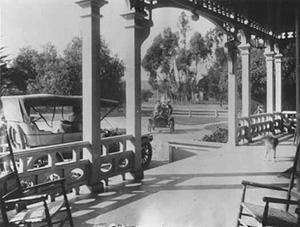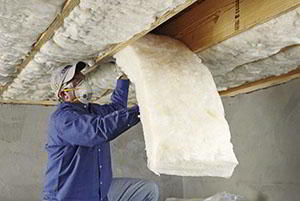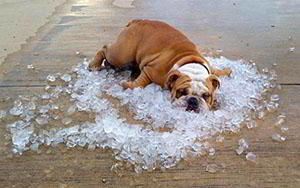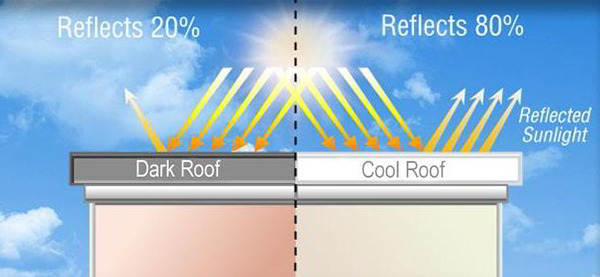Air conditioning seems to be one of those “necessities” we simply can’t do without in our modern society.
But humanity has managed to spend most of its existence without air conditioning. Electromechanical air conditioning has only been around since the beginning of the 20th century. Let’s look at some of the things people did to stay cool before modern air conditioning came along.
Related: How To Heat Your Home Without Electricity
Prior to Modern AC
 If you are building a home, then you can take these points into consideration. Before modern AC, people built their homes differently than they do now. The right structural elements and building materials made it possible for people to live relatively comfortably with the heat of the summer. Here are a few ways:
If you are building a home, then you can take these points into consideration. Before modern AC, people built their homes differently than they do now. The right structural elements and building materials made it possible for people to live relatively comfortably with the heat of the summer. Here are a few ways:
Stone, Brick, and Clay
Building materials for homes were always something thick and heavy, some natural stone-like material that could mimic the rock surrounding a cave. The stone or brick act link a heat sink, absorbing the heat that is shining down on your home and trapping it, releasing it slowly later on. This keeps a large portion of the heat out of your house, making the interior more comfortable. Modern homes and buildings are built with lighter materials that allow the heat to pass right through them.
High Ceilings
If you have ever been in an old house, one built in the 19th century or early 20th century, you might have noticed the 10-foot ceilings. These served the purpose of climate control. Heat rises, so with such high ceilings, the heat would collect in the top 3 feet, leaving the cooler air closer to the floor. People tended to only use the upstairs in the evenings and at night, with the windows open.
Ceiling Fans
Ceiling fans have long been used to help cool a home and are especially effective when used with high ceilings. Fans can be set to pull the warm air up during the summer months (pushing it down during the winter), helping to keep the cooler air down by the floor.
Basements and Split-Level Homes
The idea behind the split-level home and basements was to find a way to keep part of the home underground, where it was cooler. This would allow for good food storage and for a cooler area of the house in which to live during the heat of the summer.
Shade Trees
Having trees planted so that they provide shade for the house was a common way to keep a house cool. The trees were traditionally planted on the east and west sides of the house, keeping the sun from heating up the interior in the morning and the evening. The trees would also cool down the breeze before it reached the house.
Awnings and porches act in the same manner, shading the windows of a house to block the sun. In fact, the porch is where people went to escape the heat of inside, where they could sit and socialize in the shade with a cool breeze. And have you ever noticed all those old houses with vines, such as English Ivy, all over them? Again, the vines helped keep the heat out of the structure.
Related: Earthbag Homes: The Ultimate Bullet-Proof Retreat… Cheap and Easy to Build
Tips and Tricks for Living without Air Conditioning
Having talked about the way homes were built prior to the invention of modern AC, most people don’t actually live in those kinds of homes. Even back then, a lot of people, particularly in big cities, lived in apartments. It is more likely that you live in a home built after the use of AC in homes became common place, something from the 1920s on, or that you live in an apartment building.
If you don’t have air conditioning or don’t want to be dependent on it, then you still have some options. If you do own your own home, you can do some of the things mentioned above, such as installing ceiling fans and using awnings, building a porch, or planting trees and/or vines to provide some shade. Obviously, if you live in an apartment, you don’t have many options, but here are some things you can do, regardless of where you live:
Windows and Coverings
Have your windows open from evening to morning and then close them and all window coverings before the morning sun can start sending its first rays in through the windows. This will help keep the heat of the day out and let the cool night air in. You can couple this with closing off the warm rooms in your home.
Lights and Electrical Equipment
Lights, particularly incandescent light bulbs, and electrical equipment generate heat. When it’s hot during the day, turn off all lights and only use them when necessary, even in the evenings. Turn off all electrical equipment and appliances, or better yet, unplug them.
Related: You Will Not Survive an EMP Strike Without This
Use Appliances When It’s Cool
When you need to cook, do laundry, iron, or use any appliance that generates a significant amount of heat, do it during the hours when it is cooler, either early in the morning or in the evening. Get a clothesline and dry your clothes that way, instead of running the dryer.
 Seal and Insulate Your Home
Seal and Insulate Your Home
If you own your home, you can add extra insulation in the attic, which will help in all seasons. You can also add weather stripping, caulking, and other sealants around doors and windows to ensure you keep warm air out and cool air in.
Unusual Ways to Keep Cool
They say that back before air conditioning, when the nights were really hot, people used to sleep on their porches and people who lived in apartments took to their fire escapes. Chances are, you won’t see anyone doing that these days, although there is no reason people couldn’t. The thing is, if there is no way you can change your landscaping or add features to your home or if you live in an apartment, then you are going to have to find other ways to keep cool. Yes, you can leave your home and go to the movies, a museum, or the mall, but you can’t do that every day. Here are some unique ways to stay cool during the summer heat.
Evaporative Cooling
This is an ideal way to keep cool, but it only works in low humidity environments. If you take old linens and tack them up over open windows and then spray down the linens to make them damp, they will keep your home very cool. The dampness in the sheets will evaporate, taking the heat with it. All you need to do is rewet the sheets when they get dry. This is not only a great way to keep cool, but it works even if you have no electricity. Note that the reason this doesn’t work in a high-humidity environment is that in humid air evaporation cannot take place as efficiently, if at all.
Get Wet
You can also use water to keep yourself wet and cool. Keep your hair wet or wet a bandana and wrap it around your neck or head. You can also mist yourself, both skin and clothing, with a water bottle. Back in the 30’s, people were even known to put their underwear in the freezer before wearing it!
Create Your Own Breeze
If you have a nice breeze coming in your window, but it isn’t as cool as you would like, and you have electricity, you can make that breeze cooler. No, I’m not talking about a fan. You can do the following. Place a saucer on a windowsill and place a piece of paper towel over it. Then place a bowl on top of the paper towel and put ice in it. As the breeze blows through the window, the ice will cool it. You just have to have enough ice to get you through the hot part of the day. An alternative to this is to place the ice in a small cooler (regular or Styrofoam) and position a fan so it blows over the ice, creating a cool breeze.
Cool Down Your Bedding
You can also make your bed cooler before you climb into it. You can dampen your sheet if you wish or you can stick your sheets in the freezer before going to bed. That way they will be very cool when you settle down, helping you stay comfortable while you fall asleep. Just be sure you use cotton sheets, as they are more breathable and cooler.
A few other tips include:
 Take cool showers
Take cool showers- Stay as close to the ground/floor as possible
- Sleep alone (sorry no cuddling)
- Sleep in a hammock or cot
- Sit and sleep in the cross-breeze between windows
- Wear as little clothing as possible, keep what you do wear light in color and ensure the fabric is light and breathable
- Keep your level of activity down in the middle of the day (think siesta!)
- Drink a lot of water to keep from getting dehydrated and overheated, something that can happen before you know it in the heat
You may also like:
 Tents That Turn Into Bunkers if You Just Add Water
Tents That Turn Into Bunkers if You Just Add Water
This Bug Will Kill Most of the Americans during the Next Crisis (Video)
How to Adjust the pH in Soil and Water for Abundant Harvests
Waterproof Socks – One Step Further In Terms of Outdoors Living















Uh, people didn’t have freezers in the 1930s
No, my uncle did not have a freezer. But he did have an underground stone lined room about 5′ below grade that he would store ice he had collected from a pond during the winter. He then covered the ice with straw. He said it stayed a cold 30 to 33 degrees most of the summer. He also had a spring house for the milk, cheese and veggies.He was a wise old bird, and I learned a lot from him.
Hello T,
Let me correct your comment, if you please.
Inventions for cooling air, started in Europe but all came to fruition in the U.S.
These inventions or “fads”, of the time, quickly moved from east to west.
1748 – artificial refrigeration
1805 – vapor refrigeration
1834 – vapor/compression refrigeration system
1854 – commercial ice maker
1876 – deep freeze concept is born
1902 – air conditioning invented & put to commercial use, shortly thereafter
1913 – refrigerators for the home
1923 – self contained refrigerator/freezer units for the home
1927 – deep freeze units for the home
Hey, I love reading, history, research, numbers, and…the list goes on.
Very interesting fact sheet. I’m thinking those are invention dates in a laboratory, not when the inventions became widespread. I’m 66 years old and was raised in very much upper middle class neighborhoods. Here’s my personal timeline:
1951 — oscillating table fans, Austin, TX
1957 — beautiful oak “ice box,” Iowa City, IA
1958 — evaporative cooler, Lubbock, TX
1965 — central AC, Austin, TX
1980 — ceiling fans back into widespread use
Thanks for sharing your research.
My family moved to Pasadena, TX in 1953 and rented a house while our new house was being built. Worried about mold and mildew, my dad insisted on having central air installed in that new house which we occupied by 1954, with possibly the first private home central air in that most foul climate southeast of Houston.
In 1964-65, most of the houses in my neighborhood, if they had cooling at all, had evaporative coolers, called swamp coolers because they significantly increased the humidity inside the house. We didn’t have the luxury of a swamp cooler, so we headed to San Clement and the beachon the weekends when we got up and the temperature was already 95° at 8:00 o’clock in the morning.
In that same period I can remember an auto trip to El Centro in August for legal proceedings and we equipped the car with a swamp cooler that went in the window and we tried to keep ice in it without a lot of success.
Those were the days when anyone driving across any of the Southwest States drove with one or two canvas waterbeds draped on the front bumper for cool water. The canvas dried in the wind created by driving and then absorbed more water from inside the bag, thus dropping the temperature of the water by a significant amount to provide cool drinking water when crossing hot, arid regions.
Most cars came equipped with a/c jokingly called a 4/65 unit. You rolled down the four windows and drove 65 mph.
The statement was: “People didn’t have freezers in the 1930s.”
That statement is generally correct. As someone who has waddled around in the U.S. since 1937, I can state for a fact that air conditioning didn’t come into use in commercial buildings until the 1950s. As late at the late 1940s the ice man still delivered ice to homes in our neighborhood in suburban Philadelphia.
In the 50s in the Philadelphia suburb where I lived the new bowling alley was the first commercial building to have air conditioning. They advertised it with a huge banner stating, “IT”S COOL INSIDE!”.
It was during the 50s and early 60s that renting lockers in commercial freezers became popular. You bought a side of beef, had it butchered, wrapped and stored in the commercial food locker that has commercial freezers that they stored your food in.
It wasn’t until later in the 20th century that home freezers became ubiquitous in homes.
So like television, freezers may have been available in certain special situations, home freezers came along many years after the technology was feasible.
However, it is interesting to note how long ago technology achieved certain levels and how long it took it to gain general acceptance.
Several military leaders said about airplanes in the early days of aviation, “An interesting hobby but absolutely no military application.”
Billy Mitchell got in all that trouble because he kept insisting that an airplane could sink a battleship. The Navy brass insisted that it was impossible and court-martial Mitchell for demonstrating that an airplane could sink a ship. The Yamato, the largest battleship ever built was sunk solely by airplanes of the U.S. Navy less than 20 years after Mitchell was court-martialed for insisting it could be done.
I open my basement door and use a fan to pull cool area up from basement.
Honestly, I can’t live without an AC in our home. But sometimes I can’t avoid having an AC repair service. I think I may just hire a professional to come and look at our A.C. Wouldn’t want to break anything anymore that it is broken.
We live in AZ so we must have an AC 8 months out of the year!
Jason: I don’t know how to break this news to you, but people lived in the Phoenix, Tucson area in the 19th century long before a/c was in general use, no matter when it was invented.
Mike and Jason, I lived in Glendale 1 year. The day it was 121*, of course, my AC broke. That was memorable.
We use a heat reflector / radiant barrier in a lot of our metal building roofs. They do a pretty good job at keeping the room cooler, but there are some days when working out in the shop you just need some AC as it gets way to hot in NC.
AC is a must for me, but the next best thing is being covered in ice like that dog.
I can remember up until I went in the Marine Corps in 1955, driving through Philadelphia on a hot, humid summer night with lots and lots of people sitting out on fire escapes or the front steps (called “stoops” PA Dutch, I think) to escape the heat and humidity inside their homes or apartments. Even as late as 0200 would find folks outside. Perhaps someone would crack a fire hydrant so the kids could play in the cool water.
If you read about early settlers in Arizona and the hotter regions of New Mexico and SoCal, they used to hang wet sheets by the windows to cool the rooms down by evaporation.
You can live in extreme heat. People have done it for eons up until the late 20th century. 20th century! That give one an idea how many years folks managed without a/c, not counting all the centuries before the countdown to the current era commenced.
Best take into account no a/c after the EOTW. To paraphrase Karl Malden, “What will you do? WHAT WILL YOU DO?”
A good topic for prepping to get folks thinking about the lack of some things that we take for granted now.
LCC – Agreed. We have become *way* to reliant on our comfortable indoor climates in this modern age.
People survived and, as the article mentioned, used ingenuity when building structures to match the climate. Watched a documentary of a high plateau city in the desert along the Silk Road trade route. The people still live in these special clay buildings that have a “heat pipe” column coming out of their narrow, tall homes. It draws the heat up during the scorching daytime temps (frequently 121ºF or more) while the thick clay walls retain the heat during the cooler night temps.
I think we’ve become pretty lazy in heating/cooling our houses instead of using creative solutions. Also, we forget that the body can acclimatize to a wide-range of temperatures. When we live in a bubble of air-conditioning indoors, of course we’ll be uncomfortable when we are outside or when the power goes out. The same during winter, only in reverse. It takes about a week for your body to adjust to any given temperature as long as it isn’t a life-threatening extreme. 🙂
ACs get clogged up all the time because of dirty vents then people have to sit without until we can get to them
@left coast chuck”Jason: I don’t know how to break this news to you, but people lived in the Phoenix, Tucson area in the 19th century long before a/c was in general use, no matter when it was invented.”
I couldn’t agree more
Very impressive, thanks a lot for sharing a helpful post with us.
I like the article because it gives you helpful tips to make your life more comfortable without air conditioning. I think that this is a very good product and should be sold in all stores, especially if they sell household appliances. It will help people who want to save money on their electric bills as well as those who are looking for a way to live comfortably during summertime.
Great information Thanks for sharing, Your articles and listing are inspirational.